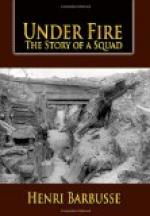An acetylene searchlight blazes blindingly out and depicts a dome of daylight. Other beams pierce and rend the universal gray.
Then does the station assume a fantastic air. Mysterious shapes spring up and adhere to the sky’s dark blue. Mountains come into view, rough-modeled, and vast as the ruins of a town. One can see the beginning of unending rows of objects, finally plunged in night. One guesses what the great bulks may be whose outermost outlines flash forth from a black abyss of the unknown.
On our left, detachments of cavalry and infantry move ever forward like a ponderous flood. We hear the diffused obscurity of voices. We see some ranks delineated by a flash of phosphorescent light or a ruddy glimmering, and we listen to long-drawn trails of noise.
Up the gangways of the vans whose gray trunks and black mouths one sees by the dancing and smoking flame of torches, artillerymen are leading horses. There are appeals and shouts, a frantic trampling of conflict, and the angry kicking of some restive animal—insulted by its guide—against the panels of the van where he is cloistered.
Not far away, they are putting wagons on to railway trucks. Swarming humanity surrounds a hill of trusses of fodder. A scattered multitude furiously attacks great strata of bales.
“That’s three hours we’ve been on our pins,” sighs Paradis.
“And those, there, what are they?” In some snatches of light we see a group of goblins, surrounded by glowworms and carrying strange instruments, come out and then disappear.
“That’s the searchlight section,” says Cocon.
“You’ve got your considering cap on, camarade; what’s it about?”
“There are four Divisions, at present, in an Army Corps,” replies Cocon; “the number changes, sometimes it is three, sometimes five. Just now, it’s four. And each of our Divisions,” continues the mathematical one, whom our squad glories in owning, “includes three R.I.—regiments of infantry; two B.C.P.—battalions of chasseurs pied; one R.T.I.—regiment of territorial infantry—without counting the special regiments, Artillery, Engineers, Transport, etc., and not counting either Headquarters of the D.I. and the departments not brigaded but attached directly to the D.I. A regiment of the line of three battalions occupies four trains, one for H.Q., the machine-gun company, and the C.H.R. (compagnie hors rang [note 2]), and one to each battalion. All the troops won’t entrain here. They’ll entrain in echelons along the line according to the position of the quarters and the period of reliefs.”
“I’m tired,” says Tulacque. “We don’t get enough solids to eat, mark you. We stand up because it’s the fashion, but we’ve no longer either force or freshness.”




